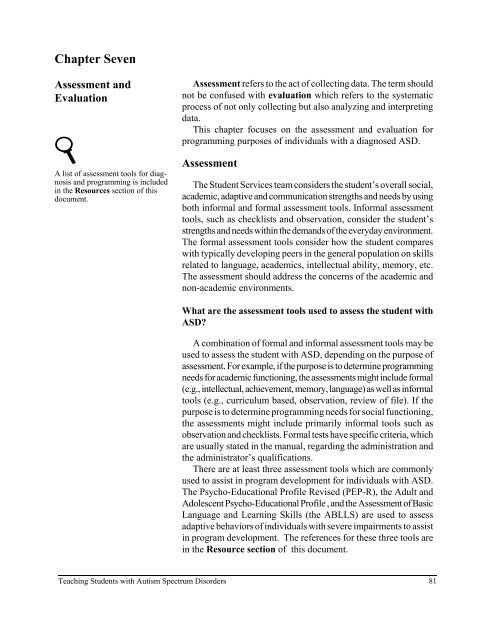Teaching Students with Autism Spectrum Disorders
Teaching Students with Autism Spectrum Disorders
Teaching Students with Autism Spectrum Disorders
Create successful ePaper yourself
Turn your PDF publications into a flip-book with our unique Google optimized e-Paper software.
Chapter Seven<br />
Assessment and<br />
Evaluation<br />
A list of assessment tools for diagnosis<br />
and programming is included<br />
in the Resources section of this<br />
document.<br />
Assessment refers to the act of collecting data. The term should<br />
not be confused <strong>with</strong> evaluation which refers to the systematic<br />
process of not only collecting but also analyzing and interpreting<br />
data.<br />
This chapter focuses on the assessment and evaluation for<br />
programming purposes of individuals <strong>with</strong> a diagnosed ASD.<br />
Assessment<br />
The Student Services team considers the student’s overall social,<br />
academic, adaptive and communication strengths and needs by using<br />
both informal and formal assessment tools. Informal assessment<br />
tools, such as checklists and observation, consider the student’s<br />
strengths and needs <strong>with</strong>in the demands of the everyday environment.<br />
The formal assessment tools consider how the student compares<br />
<strong>with</strong> typically developing peers in the general population on skills<br />
related to language, academics, intellectual ability, memory, etc.<br />
The assessment should address the concerns of the academic and<br />
non-academic environments.<br />
What are the assessment tools used to assess the student <strong>with</strong><br />
ASD?<br />
A combination of formal and informal assessment tools may be<br />
used to assess the student <strong>with</strong> ASD, depending on the purpose of<br />
assessment. For example, if the purpose is to determine programming<br />
needs for academic functioning, the assessments might include formal<br />
(e.g., intellectual, achievement, memory, language) as well as informal<br />
tools (e.g., curriculum based, observation, review of file). If the<br />
purpose is to determine programming needs for social functioning,<br />
the assessments might include primarily informal tools such as<br />
observation and checklists. Formal tests have specific criteria, which<br />
are usually stated in the manual, regarding the administration and<br />
the administrator’s qualifications.<br />
There are at least three assessment tools which are commonly<br />
used to assist in program development for individuals <strong>with</strong> ASD.<br />
The Psycho-Educational Profile Revised (PEP-R), the Adult and<br />
Adolescent Psycho-Educational Profile , and the Assessment of Basic<br />
Language and Learning Skills (the ABLLS) are used to assess<br />
adaptive behaviors of individuals <strong>with</strong> severe impairments to assist<br />
in program development. The references for these three tools are<br />
in the Resource section of this document.<br />
<strong>Teaching</strong> <strong>Students</strong> <strong>with</strong> <strong>Autism</strong> <strong>Spectrum</strong> <strong>Disorders</strong> 81

















